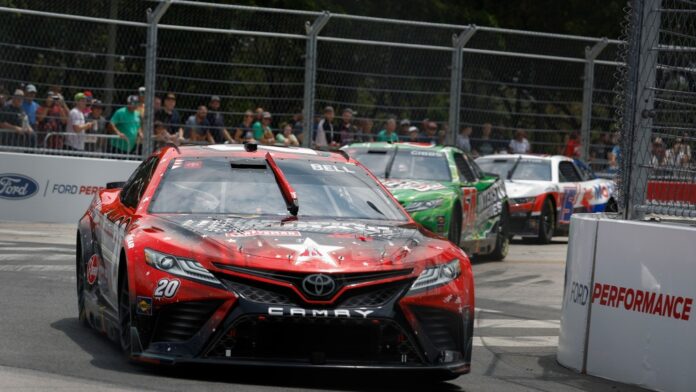Christopher Bell felt his race on the streets of Chicago was “ruined” by the timing of NASCAR officials deciding to shorten the distance of Sunday’s race due to impending darkness, while crew chief Adam Stevens called it “complete negligence.”
Bell led a race-high 37 laps and swept both stages. He was in control of the proceedings when the caution flew on lap 45, the final lap of the second stage.
Shortly thereafter, under the caution, officials informed teams the race was going to be shortened from 100 laps to 75. Racing the full distance was not realistic, and teams had begun discussing over the radio it was the likely scenario.
That includes Stevens, but he was immediately frustrated as Bell needed to make a pit stop. As Bell’s No. 20 Toyota and a majority of the leaders came down pit road, 11 other drivers stayed out and inherited the track position.
Those drivers had taken a chance and pitted under a previous caution. Doing so split the field on strategy, and with a few more cautions before the end of the race, it allowed those drivers to make the finish on fuel.
Stevens said he had been reaching out to NASCAR to make sure they were aware darkness was going to be an issue, which officials were. But Stevens said he also wanted to make sure they understood that, “They couldn’t back the race end up far enough that people that already decided to pit would back into the track position, which is what they did.
“So, they made the call too late, and the people that pit on (lap) 31 could make it on fuel with a couple of cautions, and the people that pit prior to the stage end could make it on fuel. So, it was just complete negligence that they let that happen. They should have called that prior to the lap that you could make it to the end so we all had the same chance to pit.
“The way that it was, the teams that were not handling well and running in the back pit when the cautions came and then backed into that strategy, which is not a way to run a race, in my opinion. We all knew there wasn’t enough daylight left and that we were going to have to make that decision at some point in time. They just made it so late that 12 or 13 cars had already backed into the strategy.”
Bell restarted 12th after the pit stop and with a new running order. On lap 56, any chance of a comeback ended when Bell slid sideways getting into Turn 1 and bounced off the tire barriers.
“Just racing,” Bell said of the incident. “I was racing and lost sight of my brake marker and got in too deep.”
He ultimately finished 18th.
“Just nothing we could have done there as far as the strategy stuff,” he said. “Obviously, I made a mistake getting into the tire barrier trying to come back through traffic, but I don’t know. It wasn’t meant to be today.”
NASCAR chief operating officer Steve O’Donnell explained the decision to change the race distance and informs teams when officials did as having “a lot of thought” behind it.
“At the time we made it, we waited as long as possible to see if we could get all 100 laps in,” O’Donnell said. “When we knew that wasn’t possible, we waited, we closed pit road. We wanted to make sure everybody knew what the race distance was going to be. Everyone had a chance to come in, pit the car, get fuel. We wanted to take fuel mileage out of it.
“I think we’ve had conversations with some who may have thought it was unfair who pitted on the same lap that the leader did and won. I think we’re more than comfortable with the way the decision was made in this case. Certainly, it can be second-guessed anytime you have to do this, but I feel like the process played out well. Would have liked to get all 100, but we wanted to be as fair as possible for the fans and also not put ourselves in a position where we’re getting questions of why are you racing in the dark.”
Stevens doesn’t see the need to talk to NASCAR officials.
“They know that it was stupid,” he said. “So, there’s nothing I’m going to tell them that’s going to make them change their mind on that.”



